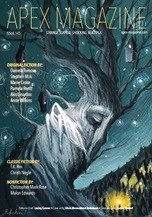“Our Lady of the Clay” by Daniela Tomova
“The Owl” by Stephen M. A.
“A Lullaby of Anguish” by Marie Croke
“Loss Prevention” by Pamela Rentz
“What is Conjured Shall Vanish” by Akis Linardos
“Intertwined” by Anne Wilkins
“Growing Swirling Clouds” by T. K. Rex (reprint, not reviewed)
“Auxiliary, Supplementary, Inessential” by Christi Nogle (reprint, not reviewed)
Reviewed by Victoria Silverwolf
Six new short stories appear in this issue, with an emphasis on horror, dark fantasy, and downbeat science fiction.
In “Our Lady of the Clay” by Daniela Tomova, a teenage boy and his much younger brother head into the woods to seek the being named in the title, in hope of restoring their dead mother to life. In addition to the supernatural dangers of the quest, they must face their own family secrets.
The fantasy content of this story is unusual and imaginative. The author undertakes the difficult task of using multiple points of view, and succeeds with style and grace. The narrative often makes use of poetic language in a way that is never unclear. Although often dark in mood, the story is not without a touch of hope.
“The Owl” by Stephen M. A. opens with the title creature, the size of a planet, arriving on Earth and asking the elderly narrator if it should save humanity from destruction. After this startling introduction, flashbacks relate how, as a child and again as a teenager, the narrator saw his friends abused by adults.
In addition to the mixture of fantasy and realism seen in the above synopsis, the story contains science fiction, in the form of a future plague that nearly wipes out the human race. The three genres do not always blend together smoothly. The realistic portions of the text are most effective, obviously written with righteous anger against cruelty.
As children, the narrator of “A Lullaby of Anguish” by Marie Croke and her sister tormented infant supernatural sea creatures by capturing them in tide pools and photographing their pain. As adults, although they have benefited from the sale of these photographs, they share a feeling of guilt about their former heartlessness. The sister arrives with an abusive boyfriend who intends to photograph the beings for himself, leading to a tragic ending.
The story suggests that people enjoy witnessing the suffering of others, if only because it awakens their empathy. The author conveys this provocative theme powerfully. The plot is less original, as it is obvious that the boyfriend is selfish and cruel and will come to a bad end. Even for a fantasy story, I had to wonder if the climax was physically possible.
“Loss Prevention” by Pamela Rentz takes place inside a facility where customers wait to be transported to an orbiting casino. The narrator works in the surveillance center, watching for any problems. An auditor arrives, looking for irregularities. He discovers that the narrator has reasons for using the surveillance equipment in unauthorized ways.
The story could easily take place in the security center of a modern casino, or at least one in the near future with more advanced technology. The fact that the casino is in orbit is irrelevant to the plot. That said, the author has a gift for characterization and deals with a contemporary problem in a thoughtful way.
“What is Conjured Shall Vanish” by Akis Linardos is the first of two very short stories inspired by writing prompts. This one is based on the prompt “grimoire.” A new emperor executes all known witches. The narrator and her mother are secretly witches. After she becomes one of the emperor’s concubines, the narrator uses magic to feed her dying mother, and to exact justice on the emperor.
The mood is very dark, and even the narrator’s revenge on the emperor involves great sacrifice. Although there are few surprises in the plot, the author, like many others in this issue, vividly portrays human cruelty.
“Intertwined” by Anne Wilkins is inspired by the prompt “skin.” It takes place in a future world where all animals are extinct. The narrator and a man both have seemingly living tattoos that not only change position on their bodies, but can actually move from one person to the other. The story goes on to explain the gruesome reason they have these tattoos.
In fitting with most of the rest of the issue, this is a dystopian tale of a very grim future. Readers should be aware that the story’s content warning gives away a major part of the climax, spoiling the effect.
Victoria Silverwolf saw a deer on her driveway the other day.
 Apex
Apex